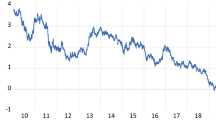Summary
In the eighties The Netherlands has recorded a marked increase in the quantity of money. This development was notably attended by a rise in money balances of nonfinancial firms. In an attempt to trace the causes of this development, the Dutch central bank conducted a large-scale survey in 1991. The results corroborate previous econometric research on disaggregate Dutch money demand functions which identifies buffering of profits as the main cause of the increased money holdings by firms. The main contribution of the survey is that it reveals pecking order financing behaviour of firms as an important microeconomic reason for this buffer stock mechanism in firms' money holdings.
Similar content being viewed by others
References
Ang, J.S. and M. Jung (1993), ‘An Alternate Test of Myer's Pecking Order Theory of Capital Structure: The Case of South Korean Firms,’Pacific-Basin Finance Journal, 1, pp. 31–46.
Baumol, W.J. (1952), ‘The Transactions Demand for Cash; An Inventory Theoretic Approach,’Quarterly Journal of Economics, 66, pp. 545–556.
BDO CampsObers (1993),Financiële monitor van het middenbedrijf: resultaten 1993, Eindhoven.
Beranek, W. (1963),Analysis for Financial Decisions, Homeward, Illinois.
Blinder, A.S. (1991), ‘Why are Prices Sticky?: Preliminary Results from an Interview Study,’American Economic Review, 81, pp. 89–96.
Borio, C.E.V., (1990), ‘Leverage and Financing of Non-financial Companies: An International Perspective,’BIS Economic Papers, 27, BIS, Basle.
Cools, C. (1991), ‘Financiële topmanagers over hun vermogensstructuur,’Maandblad voor accountancy en bedrijfseconomie, 65, pp. 87–101.
Cover, J.P. (1992), ‘Asymmetric Effects of Positive and Negative Money-supply Shocks,’Quarterly Journal of Economics, 107, pp. 1261–1282.
Cramer, J.S. and G.H. Reekers (1976), ‘Money Demand by Sector: A Survey for The Netherlands in 1971,’Journal of Monetary Economics, 2, pp. 99–112.
Donaldson, G., (1961),Corporate Debt Capacity Harvard University, Boston.
Donaldson, G. (1969),Strategy for Financial Mobility, Harvard University, Boston.
Dutton, D.S. and W.P. Gramm (1973), ‘Transaction Costs, the Wage Rate, and the Demand for Money,’American Economic Review, 63, pp. 652–665.
Fase, M.M.G. and C.C.A. Winder (1990), ‘The Demand for Money in The Netherlands Revisited,’De Economist, 138, pp. 276–301.
Gitman, L.J., E.A. Moses and I.T. White (1979), ‘An Assessment of Corporate Cash Management Practices,’Financial Management, 8, pp. 32–41.
Goldfeld, S.M. and D.E. Sichel (1990), ‘The Demand for Money,’ in: B.M. Friedman and F.H. Hahn (eds.),Handbook of Monetary Economics, I, Amsterdam, pp. 300–356.
Haan, L. de, C.G. Koedijk and J.E.J. de Vrijer (1992),De stijging van het liquiditeitsbezit in de jaren tachtig: een enquête onder Nederlandse bedrijven en financiële instellingen, Monetaire Monografieën, 12, De Nederlandse Bank NV/NIBE, Amsterdam.
Harris, M. and A. Raviv (1991), ‘The Theory of Capital Structure,’Journal of Finance, 46, pp. 297–355.
Ireland, J. and S. Wren-Lewis (1992), ‘Buffer Stock Money and the Company Sector,’Oxford Economic Papers, 44, pp. 209–231.
Jensen, M.C. (1986), ‘Agency Costs of Free Cash Flow, Corporate Finance, and Takeovers,’American Economic Review, 76, pp. 323–329.
Karni, E. (1974), ‘The Value of Time and the Demand for Money,’Journal of Money, Credit and Banking, 6, pp. 45–64.
Kale, J.R., T.H. Noe and G.G. Ramirez (1991), ‘The Effect of Business Risk on Corporate Capital Structure: Theory and Evidence,’Journal of Finance, 46, pp. 1693–1715.
Keynes, J.M. (1936),The General Theory of Employment, Interest and Money, London.
Kuipers, S.K. and B. Boertje (1988), ‘On the Causes of the Rise in the Liquidity Ratio in The Netherlands during the Early Eighties,’De Economist, 136, pp. 50–90.
Laidler, D.E.W. (1984), ‘The “Buffer Stock” Notion in Monetary Economics,’Economic Journal, 94, Supplement, pp. 17–33.
Long, J.B. de and L.H. Summers (1988), ‘How does Macroeconomic Policy Affect Output?,’Brookings Papers on Economic Activity, pp. 433–494.
Miller, M.H. and O. Orr (1966), ‘A Model of the Demand for Money by Firms,’Quarterly Journal of Economics, 80, pp. 413–435.
Muscatelli, V.A. (1988), ‘Alternative Models of Buffer Stock Money: An Empirical Investigation,’Scottish Journal of Political Economy, 35, pp. 1–21.
Myers, S.C. (1984), ‘The Capital Structure Puzzle,’Journal of Finance, 39, pp. 575–592.
Myers, S.C. and N.S. Majluf (1984), ‘Corporate Financing and Investment Decisions when Firms Have Information That Investors Do Not Have,’Journal of Financial Economics, 13, pp. 187–221.
Nationale Investeringsbank (1990),Solvabiliteit in balans, The Hague.
Nieuwenburg, C.K.F. (1969), ‘New Evidence on the Determinants of the Demand for Money: An Empirical Study of Dutch Households,’European Economic Review, 1, pp. 257–274.
Oliner, S.D. and G.D. Rudebusch (1992), ‘Sources of the Financing Hierarchy for Business Investment,’Review of Economics and Statistics, 74, pp. 643–654.
Phlips, L. (1978), ‘The Demand for Leisure and Money,’Econometrica, 46, pp. 1025–1043.
Pinegar, J.M. and L. Wilbricht (1989), ‘What Managers Think of Capital Structure Theory: A Survey,’Financial Management, 18, pp. 82–91.
Rele, H.J.M. ter (1989), ‘Het fiscale klimaat om te sparen en investeren in een aantal landen,’Onderzoeksmemorandum 58, Centraal Planbureau, The Hague.
Sterken, E. (1992), ‘The Financial Transactions Motive in the Dutch Money Demand Function,’Kredit und Kapital, 25, pp. 386–405.
Tobin, J. (1956), ‘The Interest Elasticity of the Transactions Demand for Cash,’Review of Economics and Statistics, 38, pp. 241–247.
Author information
Authors and Affiliations
Additional information
The interview study was conducted while the authors were at the Domestic Research Department of the Nederlandsche Bank. Views expressed in this paper are personal and do not necessarily reflect official positions of the Nederlandsche Bank or the International Monetary Fund. Previous versions of this paper have been presented in seminars at CentER, Tilburg and the University of Limburg, Maastricht. We are grateful to Michael Belongia, Harry Garretsen, Lex Hoogduin, Dennis Jansen, Arjo Klamer, Clemens Kool, Peter Schotman, Daniel Thornton and two anonymous referees for their useful comments and suggestions. Of course, the usual disclaimer applies.
Rights and permissions
About this article
Cite this article
de Haan, L., Koedijk, K.G. & de Vrijer, J.E.J. Buffer stock money and pecking order financing: Results from an interview study among Dutch firms. De Economist 142, 287–305 (1994). https://doi.org/10.1007/BF01431974
Issue Date:
DOI: https://doi.org/10.1007/BF01431974




